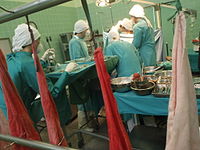
Photo from wikipedia
Tacrolimus, the cornerstone of transplantation immunosuppression, is a narrow therapeutic index drug with a low and highly variable bioavailability. Therapeutic drug monitoring based on trough level assessment is mandatory in… Click to show full abstract
Tacrolimus, the cornerstone of transplantation immunosuppression, is a narrow therapeutic index drug with a low and highly variable bioavailability. Therapeutic drug monitoring based on trough level assessment is mandatory in order to target a personalised exposure and avoid both rejection and toxicity. Population pharmacokinetic (POPPK) models might be a useful tool for improving early attainment of target range by guiding initial doses until steady state is reached and trough levels can be reliably used as surrogate marker of exposure. Here we present the first POPPK for predicting the initial doses of the once-daily prolonged release tacrolimus Envarsus (LCPT) in adult kidney recipients. The model was developed exploiting the data from a recent pharmacokinetic randomised clinical study, in which 69 de novo kidney recipients, 33 of whom treated with LCPT, underwent an intensive blood sampling strategy for tacrolimus including four complete pharmacokinetic profiles. The complex and prolonged absorption of LCPT is well described by the three-phase model that incorporates body weight and CYP3A5 genotype as significant covariates accounting for a great proportion of the inter-patient variability: in particular, CYP3A5*1/*3 expressors had a 66% higher LCPT clearance. We have then generated by simulation a personalised dosing strategy based on the model that could improve the early attainment of therapeutic trough levels by almost doubling the proportion of patients within target range (69.3% compared to 36.1% with the standard body weight-based approach) on post-transplantation day 4 and significantly reduce the proportion of overexposed patients at risk of toxicity. A POPPK model was successfully developed for LCPT in de novo kidney recipients. The model could guide a personalised dosing strategy early after transplantation. For the model to be translated into clinical practice, its beneficial impact of earlier attainment of therapeutic trough levels should be demonstrated on hard clinical outcomes in further studies.
Journal Title: Advances in Therapy
Year Published: 2021
Link to full text (if available)
Share on Social Media: Sign Up to like & get
recommendations!